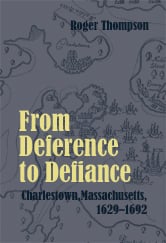 The “Great Migration” of as many as 20,000 people to New England during the 1630s was, in its long-term effects, the most important event in English seventeenth-century history. It has been depicted as a farther-reaching extension of an already mobile English population, though I have argued elsewhere that many emigrants to New England came from long-settled backgrounds. What distinguished the Great Migration was its family nature, as compared to the settling of the Chesapeake or the Caribbean, where individual young men predominated. Moreover, many arrivals in Salem, Charlestown, or Boston were members of “companies” – interrelated clans, or followers of gentlemen or ministers.
The “Great Migration” of as many as 20,000 people to New England during the 1630s was, in its long-term effects, the most important event in English seventeenth-century history. It has been depicted as a farther-reaching extension of an already mobile English population, though I have argued elsewhere that many emigrants to New England came from long-settled backgrounds. What distinguished the Great Migration was its family nature, as compared to the settling of the Chesapeake or the Caribbean, where individual young men predominated. Moreover, many arrivals in Salem, Charlestown, or Boston were members of “companies” – interrelated clans, or followers of gentlemen or ministers.
Dorset
Among the first arrivals of the Great Migration to Mishawum – later Charlestown – were the three Sprague brothers: Ralph, a fuller; Richard, a merchant; and William, a yeoman. The Spragues’ origins connect them with the powerful West Country transatlantic fishing and colonizing impulse. Upwey, their birthplace, was a village on the main road between Dorchester, the county seat of Dorset, and, eight miles to the south, Weymouth, its major port, from which fleets of up to eighty vessels sailed each year to the cod banks of Newfoundland and the North Atlantic.
Bristol
The second company came from Bristol, “the metropolis of the west” and England’s second port. Among the Charlestown settlers from this area were James Carey, a draper from a leading commercial family who arrived in 1639, and Richard Russell, woolen draper and son-in-law of the famous Alderman William Pitt (1640). From the upstream Severn Valley town of Tewksbury came Barnabas Davis (1639). Another useful visitor (and later citizen) was Nicholas Shapleigh, master of the George of Bristol (in 1635) and the Bristol Merchant (in 1637).
Dunstable
The third mercantile group came from the Dunstable area of Bedfordshire; they were followers of the Rev. Zechariah Symmes, who sailed on the Griffin in 1634. Mrs. Anne Hutchinson was another passenger, as was the nonconformist minister the Rev. John Lathrop of Eastwell, Kent.
Further members of the Dunstable company were the families of Thomas Lynde (1634), Robert Long (1635), George Bunker (1634), and his brother-in-law William Johnson (1634). These families, with their similar backgrounds, provided sea captains, innkeepers, merchants, and shipwrights to later generations.
Stepney
By far the most influential company in the founding and successful expansion of Charlestown arrived from the huge London East End parish of Stepney. In this hectic boom town there were islands of “solid bourgeois prosperity,” even some “merchant princes” who wished to be near their businesses. Within these respectable groups, traditions of religious dissent were often long-held and deep-seated.
One of the leading vestrymen of St. Dunstan’s Church in Stepney was the merchant John Vassall, whose sons Samuel and William were among the founders of Massachusetts. At least twenty-one East London families, most of them seafaring, artisanal, or trading, made the hazardous journey to Charlestown during the 1630s and 1640s.
Southwark
The last group brings us across London Bridge to London’s southern suburbs, the South Bank communities of Southwark and its neighbors Bermondsey and Lambeth. The most illustrious of the Southwark emigrants was undoubtedly the Rev. John Harvard (1607–1638), who arrived in Charlestown in 1637 with his young bride, Ann (Sadler). When he died childless in 1638, he left £800 and his library to the New College in Cambridge, which now bears John’s name.
Although our knowledge of the backgrounds of many members of these founding companies of Charlestown is often scanty or nonexistent, the better-documented families exhibit important common characteristics. The first is age: many of the early emigrants were in their 20s or 30s. Sometimes they were recently married, like the Nowells, the Coytmores, the Russells, the Harvards, or the Hodges. Settlement in New England was a fresh start in more sense than one. Sometimes a parent had recently died, releasing family assets and also the necessity for care. This was the case with Thomas Graves, John Harvard, and Thomas Coytmore, and was a frequent pattern among emigrants generally.
Adapted from Roger Thompson’s From Deference to Defiance.
Share this:

About Roger Thompson
Roger Thompson is the author of Sex in Middlesex, Divided We Stand, Cambridge Cameos, and From Deference to Defiance, among other works.View all posts by Roger Thompson →